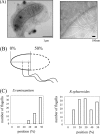Characterization of lateral flagella of Selenomonas ruminantium
- PMID: 21335384
- PMCID: PMC3126368
- DOI: 10.1128/AEM.00286-11
Characterization of lateral flagella of Selenomonas ruminantium
Abstract
Selenomonas ruminantium produces a tuft of flagella near the midpoint of the cell body and swims by rotating the cell body along the cell's long axis. The flagellum is composed of a single kind of flagellin, which is heavily glycosylated. The hook length of S. ruminantium is almost double that of Salmonella.
Figures






Similar articles
-
Structure of the Na+-driven flagellum from the homoacetogenic bacterium Acetobacterium woodii.FEBS Lett. 1998 Sep 4;434(3):325-8. doi: 10.1016/s0014-5793(98)01008-4. FEBS Lett. 1998. PMID: 9742948
-
Total reconstitution of Salmonella flagellar filaments from hook and purified flagellin and hook-associated proteins in vitro.J Mol Biol. 1989 Sep 5;209(1):109-14. doi: 10.1016/0022-2836(89)90174-5. J Mol Biol. 1989. PMID: 2810363
-
Flagellar growth in a filament-less Salmonella fliD mutant supplemented with purified hook-associated protein 2.J Biochem. 1993 Jul;114(1):39-44. doi: 10.1093/oxfordjournals.jbchem.a124136. J Biochem. 1993. PMID: 8407873
-
The archaeal flagellum: a different kind of prokaryotic motility structure.FEMS Microbiol Rev. 2001 Apr;25(2):147-74. doi: 10.1111/j.1574-6976.2001.tb00575.x. FEMS Microbiol Rev. 2001. PMID: 11250034 Review.
-
Bacterial and archaeal flagella as prokaryotic motility organelles.Biochemistry (Mosc). 2004 Nov;69(11):1203-12. doi: 10.1007/s10541-005-0065-8. Biochemistry (Mosc). 2004. PMID: 15627373 Review.
Cited by
-
Application of propionate-producing bacterial consortium in ruminal methanogenesis inhibited environment with bromoethanesulfonate as a methanogen direct inhibitor.Front Vet Sci. 2024 Oct 9;11:1422474. doi: 10.3389/fvets.2024.1422474. eCollection 2024. Front Vet Sci. 2024. PMID: 39444738 Free PMC article.
-
YSMR: a video tracking and analysis program for bacterial motility.BMC Bioinformatics. 2020 Apr 29;21(1):166. doi: 10.1186/s12859-020-3495-9. BMC Bioinformatics. 2020. PMID: 32349658 Free PMC article.
-
Bacterial motility: machinery and mechanisms.Nat Rev Microbiol. 2022 Mar;20(3):161-173. doi: 10.1038/s41579-021-00626-4. Epub 2021 Sep 21. Nat Rev Microbiol. 2022. PMID: 34548639 Review.
-
Novel methods for analysing bacterial tracks reveal persistence in Rhodobacter sphaeroides.PLoS Comput Biol. 2013 Oct;9(10):e1003276. doi: 10.1371/journal.pcbi.1003276. Epub 2013 Oct 24. PLoS Comput Biol. 2013. PMID: 24204227 Free PMC article.
-
The polar and lateral flagella from Plesiomonas shigelloides are glycosylated with legionaminic acid.Front Microbiol. 2015 Jun 26;6:649. doi: 10.3389/fmicb.2015.00649. eCollection 2015. Front Microbiol. 2015. PMID: 26167161 Free PMC article.
References
-
- Adler J., Templeton B. 1967. The effect of environmental conditions on the motility of Escherichia coli. J. Gen. Microbiol. 46:175–184 - PubMed
-
- Aizawa S.-I. 2009. Flagella, p. 393–403 In Schaechter M. (ed.), Encyclopedia of microbiology. Elsevier, Oxford, United Kingdom
MeSH terms
Substances
LinkOut - more resources
Full Text Sources

